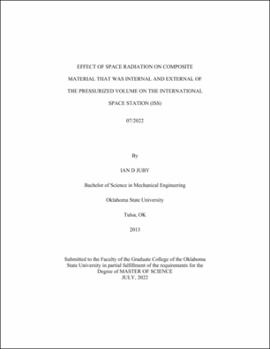| dc.contributor.advisor | Vaidyanathan, Ranji | |
| dc.contributor.author | Juby, Ian D. | |
| dc.date.accessioned | 2023-04-12T19:38:33Z | |
| dc.date.available | 2023-04-12T19:38:33Z | |
| dc.date.issued | 2022-07 | |
| dc.identifier.uri | https://hdl.handle.net/11244/337366 | |
| dc.description.abstract | The focus of this study will be on the effects that radiation environments on ISS have on composite coupons. Coupons from two different experimental programs HiMassSEE and MISSE-11 were used to run testing on. The HiMassSEE coupons were internal to the pressurized volume and had high atomic number metallic foils in between the coupons to enhance the possibility of high energy secondary particle impacts. These impacts were seen on CR-39/Mica coupons that were processed by the material labs at Johnson Space Center. The concern with secondary impacts is how it effects the performance of the composite and whether there is a concern of early failure. The MISSE-11 coupons were primarily used for structural support for SC2020 coupons which were HDPE coupons with BN blended into the coupons. However there was interest in how being external to ISS would affect the mechanical properties of the carbon fiber coupons without shielding. Various tests were performed on each coupon set, unfortunately due to limitation of dimensions and quantity of coupons, side by side comparison of results of the HiMassSEE and MISSE-11 coupons could not be performed. For the HiMassSEE coupons, Differential Scanning Calorimetry (DSC), Fourier transform infrared Spectroscopy (FTIR) and Scanning Electron Microscopy (SEM) were performed. The DSC results demonstrated that the coupons were fully cross-linked prior to being flown and showed no enhanced cross-linking on top of what the ground controls showed. The FTIR results showed that there were increases in the aromatic ring structures and oxidation which suggests that enhanced chain scission was occurring on the surface of the coupons. There was also a distinct increase in absorbance peaks on each of the coupons in order of the atomic number (Z) which demonstrated that more activity within in the molecular structure of the coupons was occurring. The only coupon to not have these increases, but instead decreased in absorbance were the coupons with Niobium foils. Further studies are needed to determine that understanding of why this occurred. The SEM images for both the HiMassSEE and MISSE-11 coupons produced no signs of high energy particle impact in the form of track marks or epoxy degradation in which fibers were no longer adhered in the matrix. Dynamic mechanical analysis (DMA) showed the MISSE-11 coupons underwent very small changes in the material properties which could be contributed to cross-linking. The flight coupons demonstrated difference when compared to the ground controls, which was contributed to the orientated direction of the coupons. Both sets of experimental results displayed that radiation exposure in LEO provides negligible effects to composite performance. There does however still need to be research into the effect of radiation outside of LEO in deep space and lunar environments where the next generation of space exploration will occur. | |
| dc.format | application/pdf | |
| dc.language | en_US | |
| dc.rights | Copyright is held by the author who has granted the Oklahoma State University Library the non-exclusive right to share this material in its institutional repository. Contact Digital Library Services at lib-dls@okstate.edu or 405-744-9161 for the permission policy on the use, reproduction or distribution of this material. | |
| dc.title | Effect of space radiation on composite material that was internal and external of the pressurized volume on the International Space Station (ISS) | |
| dc.contributor.committeeMember | Singh, Raman | |
| dc.contributor.committeeMember | Benton, Eric | |
| osu.filename | Juby_okstate_0664M_17869.pdf | |
| osu.accesstype | Open Access | |
| dc.type.genre | Thesis | |
| dc.type.material | Text | |
| dc.subject.keywords | composites | |
| dc.subject.keywords | degradation | |
| dc.subject.keywords | high atomic number | |
| dc.subject.keywords | radiation | |
| dc.subject.keywords | shielded | |
| dc.subject.keywords | unshielded | |
| thesis.degree.discipline | Materials Science and Engineering | |
| thesis.degree.grantor | Oklahoma State University | |
